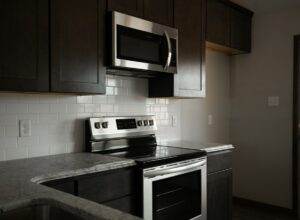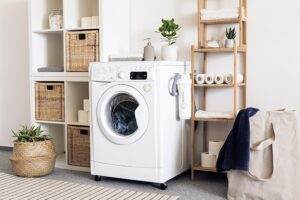Introduction to KitchenAid Refrigerator Repair
KitchenAid is a well-known and trusted brand when it comes to kitchen appliances, and their refrigerators are no exception. KitchenAid refrigerators are known for their sleek design, innovative features, and reliable performance. However, like any other appliance, they can experience issues over time. That’s why proper maintenance and repair are essential to keep your KitchenAid refrigerator running smoothly.
Proper maintenance and repair of your KitchenAid refrigerator are crucial for several reasons. First and foremost, it ensures that your refrigerator is functioning at its best, keeping your food fresh and safe to consume. Regular maintenance can also help prevent costly repairs down the line by catching any potential issues early on. Additionally, a well-maintained refrigerator is more energy-efficient, which can save you money on your utility bills.
Common Problems with KitchenAid Refrigerators
While KitchenAid refrigerators are generally reliable, there are some common issues that can arise over time. One common problem is a refrigerator that is not cooling properly. This can be caused by a faulty thermostat, a malfunctioning compressor, or a clogged condenser coil. Another common issue is a refrigerator that is leaking water. This can be due to a blocked defrost drain or a faulty water inlet valve.
Other common problems include ice buildup in the freezer, a noisy refrigerator, or a refrigerator that is not dispensing water or ice properly. These issues can be caused by various factors such as a defective fan motor, a malfunctioning ice maker, or a faulty dispenser switch. It’s important to pay attention to any symptoms or signs of these problems so that you can address them promptly.
Troubleshooting Tips for KitchenAid Refrigerators
Before calling a professional for repair, there are some basic troubleshooting steps you can take to try and identify the root cause of the problem. First, check the power supply to ensure that the refrigerator is receiving power. Make sure the power cord is securely plugged in and that the circuit breaker has not tripped. If the refrigerator is not cooling properly, check the temperature settings to ensure they are set correctly.
If you notice any unusual noises coming from your refrigerator, try to identify where the noise is coming from. It could be a loose or faulty fan motor, a malfunctioning compressor, or a problem with the condenser coil. If your refrigerator is leaking water, check the defrost drain for any blockages or ice buildup. If the water dispenser or ice maker is not working properly, check the water supply line and make sure it is not kinked or blocked.
DIY KitchenAid Refrigerator Repair: What You Need to Know
If you’re comfortable with DIY repairs and have some basic tools and equipment, you may be able to tackle some common KitchenAid refrigerator repairs yourself. However, it’s important to note that not all repairs should be attempted by inexperienced individuals, as it can be dangerous and may void your warranty. Always refer to your refrigerator’s user manual for specific instructions and safety precautions.
Before attempting any repairs, make sure you have the necessary tools and equipment. This may include a multimeter for testing electrical components, screwdrivers of various sizes, pliers, and a socket set. It’s also important to wear safety goggles and gloves to protect yourself from any potential hazards.
When it comes to DIY repairs, it’s crucial to identify the root cause of the problem before attempting any fixes. This can be done through careful observation and testing of various components. Once you have identified the faulty part or component, you can then proceed with the necessary repairs.
How to Replace a Faulty KitchenAid Refrigerator Part
If you have identified a faulty part in your KitchenAid refrigerator that needs to be replaced, there are a few steps you can follow to ensure a successful replacement. First, make sure you have the correct replacement part for your specific refrigerator model. You can usually find this information in your refrigerator’s user manual or by contacting the manufacturer.
Next, unplug the refrigerator from the power source to ensure your safety. Depending on the part you need to replace, you may need to remove shelves, drawers, or other components to gain access to the faulty part. Follow the instructions in your user manual or refer to online resources for step-by-step guidance on how to remove and replace the specific part.
Once you have successfully replaced the faulty part, reassemble any components that were removed and plug the refrigerator back into the power source. Test the refrigerator to ensure that the new part is functioning properly. If you’re unsure about any step of the process or encounter any difficulties, it’s best to seek professional help.
Maintenance Tips for Your KitchenAid Refrigerator
Proper maintenance is key to keeping your KitchenAid refrigerator running smoothly and preventing future issues. Here are some maintenance tips to help you keep your refrigerator in top condition:
1. Clean the condenser coils: The condenser coils are responsible for removing heat from the refrigerator. Over time, they can become clogged with dust and debris, which can affect their efficiency. Regularly clean the condenser coils using a vacuum cleaner or a brush to remove any buildup.
2. Check and replace the water filter: If your KitchenAid refrigerator has a water dispenser or ice maker, it likely has a water filter that needs to be replaced regularly. Check your user manual for instructions on how often to replace the water filter and follow them accordingly.
3. Keep the refrigerator clean: Regularly clean the interior of your refrigerator using a mild detergent and warm water. Pay special attention to spills and stains, as they can harbor bacteria and odors. Also, clean the door seals with a damp cloth to ensure a tight seal.
4. Avoid overloading the refrigerator: Overloading the refrigerator can restrict airflow and affect its cooling efficiency. Be mindful of how much food you store in the refrigerator and ensure that there is enough space for proper air circulation.
5. Keep the refrigerator level: A refrigerator that is not level can cause doors to not close properly, leading to temperature fluctuations and energy waste. Use a level to check if your refrigerator is sitting evenly on the floor and adjust the leveling feet if necessary.
How to Clean and Organize Your KitchenAid Refrigerator
Keeping your KitchenAid refrigerator clean and organized is not only aesthetically pleasing but also essential for food safety. Here are some tips to help you keep your refrigerator in top shape:
1. Regularly clean spills and stains: Clean up any spills or stains immediately to prevent them from becoming harder to remove later on. Use a mild detergent and warm water to clean the interior of your refrigerator, paying special attention to shelves, drawers, and door seals.
2. Organize food properly: Proper organization of food in your refrigerator can help prevent cross-contamination and ensure that perishable items are stored at the correct temperature. Keep raw meats separate from other foods, store leftovers in airtight containers, and use clear storage bins to group similar items together.
3. Rotate food regularly: To prevent food waste, make sure to rotate your food regularly so that older items are used first. This will also help you keep track of what you have in your refrigerator and avoid buying duplicates.
4. Keep an eye on expiration dates: Regularly check the expiration dates of items in your refrigerator and discard any that have expired. This will help prevent the growth of bacteria and ensure that you’re consuming fresh and safe food.
5. Use odor absorbers: To prevent odors from developing in your refrigerator, consider using odor absorbers such as baking soda or activated charcoal. Place them in an open container or a small cloth bag and replace them every few months.
Upgrading Your KitchenAid Refrigerator: What to Consider
If you’re considering upgrading your KitchenAid refrigerator, there are several factors to consider before making a decision. Here are some things to keep in mind:
1. Size and capacity: Determine the size and capacity of the refrigerator that will best suit your needs. Consider the available space in your kitchen and the amount of food you typically store in your refrigerator.
2. Energy efficiency: Look for refrigerators that are Energy Star certified, as they are more energy-efficient and can help you save on your utility bills. Consider features such as LED lighting, adjustable temperature controls, and smart technology that can further enhance energy efficiency.
3. Features and functionality: Think about the features and functionality that are important to you. Do you want a refrigerator with a water dispenser or an ice maker? Would you benefit from adjustable shelves or humidity-controlled drawers? Consider your lifestyle and preferences when choosing a refrigerator.
4. Budget: Set a budget for your refrigerator upgrade and stick to it. Consider the long-term savings that an energy-efficient refrigerator can provide, as well as any additional costs such as installation or extended warranties.
5. Read reviews and compare models: Before making a final decision, read reviews of different models and compare their features, performance, and reliability. This will help you make an informed decision and choose the best refrigerator for your needs.
Benefits of Professional KitchenAid Refrigerator Repair
While DIY repairs can be cost-effective, there are several benefits to hiring a professional for KitchenAid refrigerator repair:
1. Expertise and experience: Professional repair technicians have the knowledge, expertise, and experience to diagnose and fix complex issues with your refrigerator. They have access to specialized tools and equipment that may not be readily available to the average homeowner.
2. Time-saving: Hiring a professional can save you time and effort. They can quickly identify the root cause of the problem and efficiently repair your refrigerator, minimizing downtime and inconvenience.
3. Warranty protection: If your refrigerator is still under warranty, attempting DIY repairs may void the warranty. Hiring a professional ensures that the repairs are done correctly and in compliance with the manufacturer’s guidelines, protecting your warranty.
4. Safety: Refrigerators contain electrical components and refrigerants that can be dangerous if mishandled. Professional repair technicians are trained to handle these components safely, reducing the risk of accidents or injuries.
5. Peace of mind: Hiring a professional gives you peace of mind knowing that your refrigerator is in capable hands. They will stand behind their work and provide warranties on parts and labor, giving you reassurance that the repairs are done correctly.
Are the Repair Tips for Whirlpool Fridge Also Applicable to KitchenAid Refrigerators?
Yes, many whirlpool fridge repair tips can also be used for KitchenAid refrigerators. Both brands are owned by the same company and share many similar parts and components. When it comes to common refrigerator issues like leaks, temperature problems, or strange noises, the repair tips can often be applied to both Whirlpool and KitchenAid models.
Conclusion: Keeping Your KitchenAid Refrigerator Running Smoothly
Proper maintenance and repair are essential for keeping your KitchenAid refrigerator running smoothly and extending its lifespan. Regularly check for common problems such as cooling issues, water leaks, or unusual noises, and address them promptly. If you’re comfortable with DIY repairs, follow safety precautions and refer to your user manual for guidance.
However, for complex issues or if you’re unsure about any step of the repair process, it’s best to seek professional help. Professional repair technicians have the expertise, experience, and tools necessary to diagnose and fix issues with your refrigerator efficiently and safely.
Remember to also prioritize regular maintenance tasks such as cleaning the condenser coils, replacing the water filter, and keeping your refrigerator clean and organized. By following these tips and seeking professional help when needed, you can keep your KitchenAid refrigerator running smoothly for years to come.
If you’re in need of kitchen aid refrigerator repair, look no further than 911 Appliance. They offer a wide range of services to ensure your refrigerator is running smoothly and efficiently. In their blog section, they have an informative article on common refrigerator issues and how to troubleshoot them. Whether it’s a faulty compressor or a leaking water dispenser, this article provides helpful tips and tricks to help you diagnose and potentially fix the problem yourself. Check out their blog post on refrigerator troubleshooting here.



